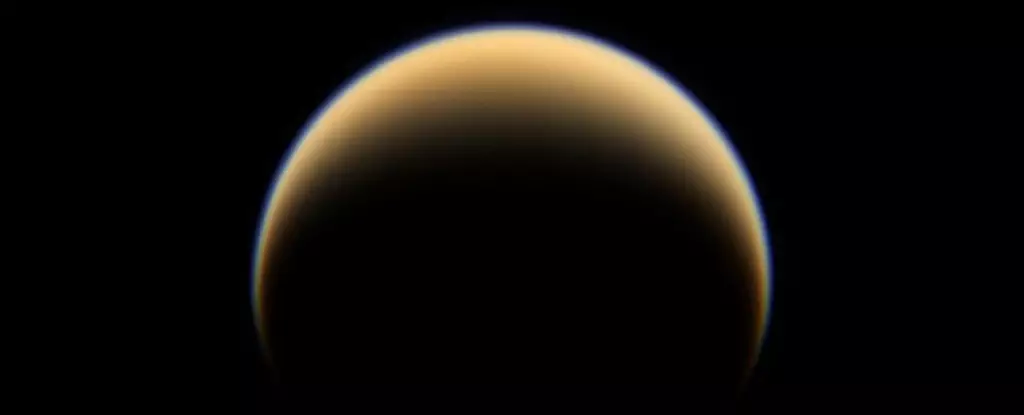Titan, Saturn’s largest moon, has long captured the imagination of scientists and enthusiasts alike as a potential cradle for extraterrestrial life. Its thick atmosphere, rich in organic compounds, and the presence of a subsurface ocean beneath a vast icy crust make it uniquely alluring among Solar System bodies. Yet, despite its tantalizing features, recent research suggests that the possibility of life thriving in Titan’s hidden waters might be much more tenuous than previously hoped. Instead of a thriving biosphere, what we may be looking at is a sparse, almost negligible, microbial presence—if any at all.
The idea that Titan could host an underground habitat for life hinges on several factors: the availability of liquid water, organic molecules, and enough energy to sustain metabolic processes. While it’s true that Titan presents the necessary ingredients in abundance—methane, complex organics, and a deep, liquid water layer—the energy budget for supporting life appears starkly limited. The moon’s organic molecules, originating from atmospheric chemistry and surface interactions, are continually deposited into its ocean, but their conversion into usable energy for microbes may be minimal. This stark reality challenges the romanticized notion of Titan as a lively alien ecosystem.
The Improbability of Robust Life Based on Current Estimates
A research-led examination of Titan’s potential biosphere reveals a startling detail: if life exists in Titan’s ocean, it might be no more substantial than a small dog—no exaggeration. This conclusion stems from bioenergetic modeling, which calculates how much energy microbes could extract from the organic molecules present. The models indicate that the energy flux in Titan’s subsurface ocean might be too meager to sustain more than a handful of microscopic organisms, each vastly fewer in number than wetlands or even the most barren deserts on Earth.
Such an environment would mean that the biosphere is essentially a biological ghost town—one that contains perhaps a few molecules of microbial life scattered through an ocean spanning thousands of kilometers. If taken literally, this paints a picture of a universe where extraterrestrial life, although theoretically possible, may be so scarce and fragile that it defies detection. Instead of lush microbial communities, we might be talking about biological remnants existing at the edge of viability—a stark contrast to the vibrant ecosystems found elsewhere on Earth.
The Organic Molecules and the Energy Conundrum
The presence of organic molecules such as glycine is a common feature in many celestial bodies, not just Titan. These compounds are abundant in comets, asteroids, and molecular clouds, making their arrival on Titan plausible over geologic timescales. Yet, their mere presence doesn’t guarantee a thriving biosphere. Much of the organic material likely remains in inert forms, unable to be utilized by microbes without significant chemical transformation.
The process of fermentation—an ancient, simple metabolic pathway—has been proposed as the most plausible candidate for sustaining any potential microbes. Unlike aerobic respiration, fermentation does not require oxygen. Instead, it relies on organic molecules like glycine as a fuel source, breaking them down anaerobically to produce energy. This process is well-understood on Earth, powering everything from yogurt cultures to bacteria in oxygen-free environments. But even here lies a major obstacle: the energy yield is minimal, meaning that microbial populations would be infinitesimally small, spread thinly across an enormous volume of water.
It’s striking to consider that even if organic molecules are constantly arriving, the rate at which they can be harnessed for energy is so low that the total biomass might be dwarfed by a typical pet’s weight. The implications are sobering: Titan’s ocean, vast as it is, could host only a handful of microbial cells—an almost imperceptible feat of life, more like a myth of biology than a reality.
A Pessimistic Outlook or a Realistic Perspective?
Skeptics might argue that this isn’t the final word—they may see this as a conservative estimate, perhaps too dismissive of Titans’ true potential. After all, microbial life on Earth thrives in environments where energy is scant, often in extreme and seemingly inhospitable places, suggesting that life can persist under conditions far less generous than those on our planet. Some researchers posit that alternative energy sources, such as radiolysis or chemical reactions with rocky minerals, could supplement the energy deficit, allowing a more substantial biosphere to develop.
However, the current models and observational evidence lean toward a sobering conclusion: Titan’s subsurface ocean is not teeming with life but is instead a near-empty biological desert. The low energy flux limits the size and sustainability of any microbial community. This isn’t to say the moon isn’t scientifically intriguing or worth exploration—far from it. It highlights the importance of understanding that “potential habitability” is not synonymous with “rich ecosystems,” especially in the universe’s extreme environments.
In essence, Titan exemplifies the brutal reality that the ingredients for life are necessary but not sufficient. The moon’s organic bounty may be a baseline, but without more substantial energy sources or favorable conditions, life might be relegated to a rare, almost mythical occurrence—a fragile whisper in the cosmic silence. While this may temper our initial enthusiasm, it also serves as a sobering reminder that nature’s corners can be incredibly inhospitable, even when they seem primed for habitation.

